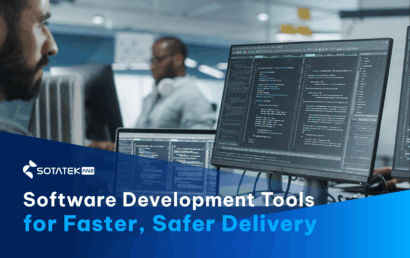Introduction
As businesses in Australia and New Zealand face increasing pressure to innovate and improve efficiency, adopting advanced digital solutions is becoming more critical than ever. SAP S/4HANA, SAP's next-gen ERP system, offers organizations the tools they need to enhance business performance and streamline their operations. With its powerful real-time data processing capabilities built on SAP HANA’s in-memory database, SAP S/4HANA empowers businesses to make data-driven decisions faster and more effectively.
SotaTek ANZ, a leader in SAP Development, is helping companies across the region leverage the benefits of SAP S/4HANA’s modular design, ensuring each organization can tailor the system to meet its unique needs. As digital transformation accelerates, SAP S/4HANA provides businesses with the flexibility and scalability to thrive in today’s fast-moving marketplace.
What is SAP S/4HANA?
SAP S/4HANA is an advanced ERP suite built on SAP’s in-memory computing platform, designed to optimize business performance through real-time data processing. With SAP S/4HANA, businesses can integrate all their core processes, including finance, supply chain, manufacturing, into a single, cohesive system. The modular nature of SAP S/4HANA design allows businesses to select specific modules based on their needs, ensuring that each company gets a tailored solution for their unique requirements. Built on the SAP HANA platform, this ERP SAP system leverages Machine Learning and Artificial Intelligence to not only run operations smoothly but also predict trends and drive business innovation. For businesses in Australia & New Zealand, SAP S/4HANA ability to offer cloud or on-premise deployment options further enhances its flexibility, making it an ideal choice for those looking to future-proof their operations and stay ahead in an ever-evolving marketplace.
But have you ever been confused when hearing SAP S/4HANA and SAP HANA? Although their names are similar, SAP S/4HANA and SAP HANA are distinct. SAP HANA is an in-memory database that stores and processes data entirely in RAM, enabling faster data access and processing. SAP S/4HANA, built on SAP HANA, is an ERP system that uses this database technology to integrate and manage various business functions. In short, SAP HANA is the underlying database, while SAP S/4HANA is the ERP application that utilizes this database for enhanced performance.
Related: What is SAP?: 4 Key SAP Modules and Applications for ANZ Businesses
Key Features of SAP S/4HANA

SAP S/4HANA uses a database and inherits many features of SAP HANA (Source: ngsc.vn)
SAP S/4HANA leverages the power of SAP HANA’s in-memory database, enhancing its features for faster and more efficient business operations. Here are some of the key features:
- High-Speed Data Processing: SAP S/4HANA eliminates the need for certain middleware, processing data at an extremely high speed. This is made possible by simplifying the data model and reducing intermediate tables, which allows for quicker computational processing.
- Improved UI and UX: With SAP S/4HANA, the user interface (UI) and user experience (UX) have been significantly enhanced. The configuration has been streamlined for ease of use, reducing the need for multiple screen switches and improving work efficiency.
- Bundling of Functions: SAP S/4HANA integrates core business functions by reducing redundancy between Supply Chain Management (SCM) and Customer Relationship Management (CRM). Additionally, it merges the Online Transaction Processing (OLTP) and Online Analytical Processing (OLAP) systems, enabling multiple business activities to run on a unified platform.
- OLTP (Online Transaction Processing): This system is used for processing transactional data, commonly applied in banking, business administration, retail services, and more.
- OLAP (Online Analytical Processing): Unlike OLTP, OLAP focuses on data analysis, processing large data sets efficiently. It is mainly used by analysts and management for data querying and decision-making.
By integrating these systems and improving core functionalities, SAP S/4HANA provides businesses with a more efficient, simplified, and user-friendly ERP solution.
Benefits of SAP S/4HANA Adoption in Australia & New Zealand
The adoption of S/4HANA offers significant opportunities for businesses in Australia and New Zealand to improve business performance, streamline processes, and stay competitive in a rapidly evolving market. By integrating advanced ERP SAP technology with real-time data processing capabilities, SAP S/4HANA enables companies to optimize operations and make more informed decisions. Below are some of the key Benefits of S/4HANA:
Faster Decision-Making: SAP S/4HANA enables enterprises to make quick, data-driven decisions by centralizing business data and providing real-time event monitoring. This is especially beneficial for SAP digital transformation initiatives, allowing businesses to analyze and report on the same system without delays. Particularly for businesses in Australia, SAP S/4HANA empowers quicker responses to market changes and operational demands.
High-Speed Data Processing for Enhanced Efficiency: It leverages in-memory database technology, allowing businesses to process large volumes of data at high speeds. The integration of various operational functions into one system reduces data entry time and ensures synchronization across tasks, driving improvements in overall work efficiency and productivity.
Flexible Deployment: On-Premises and Cloud: SAP S4 HANA supports both on-premises and cloud deployments, providing businesses in Australia and New Zealand with the flexibility to choose the solution that best fits their needs. On-premises deployment offers full control over data and enhanced security, while cloud deployment facilitates scalability and remote access, making it an ideal solution for growing businesses.
Improved Security: With SAP S4 HANA, businesses benefit from robust security features such as centralized data management and strong internal controls. These measures ensure the protection of sensitive data, which is crucial for SAP digital transformation efforts in today’s highly regulated business environment.
Proposing New Improvements and Innovations: S/4HANA's ability to integrate data across departments enables businesses to analyze inputs and continuously propose improvements. This promotes a culture of innovation, enhances operational efficiency, and supports long-term growth.
Optimizing Business Processes: By automating business processes across finance, human resources, production, and distribution, this ERP SAP reduces manual tasks and enhances resource management. This optimization leads to greater efficiency, improved decision-making, and a more agile organization.
Through SAP S/4HANA Adoption in Australia & New Zealand, businesses can gain a competitive edge, streamline their operations, and future-proof their processes, ensuring that they remain adaptable in an ever-evolving marketplace.
Read more: Top 5 Benefits of SAP Development for Businesses in Australia and New Zealand
Greenfield vs. Brownfield SAP S/4HANA Implementation: What to Choose?
When adopting SAP S/4HANA, businesses in Australia and New Zealand face an important decision regarding the implementation strategy: Greenfield or Brownfield. Both approaches offer distinct advantages and challenges, depending on the organization's current infrastructure, business goals, and digital transformation needs. Here's a breakdown of each approach to help businesses determine which one is best for their situation.

Greenfield vs. Brownfield SAP S/4HANA Implementation
Greenfield SAP S/4HANA Implementation: Starting Fresh
A Greenfield implementation refers to building an entirely new SAP S/4HANA system from scratch, without the need to integrate with any existing infrastructure or legacy systems. This approach is ideal for companies that are looking to modernize their operations completely or those that are scaling up and need a fresh, optimized ERP solution.
Advantages:
- Clean Slate: With no legacy systems to worry about, businesses can design and implement SAP S/4HANA to meet their exact needs, optimizing processes from the ground up.
- Future-Proofing: Since the system is built to accommodate the latest technology, businesses can integrate the most advanced features of S/4HANA, including machine learning, AI, and real-time analytics.
- Reduced Complexity: Without the need for complex legacy system integration, a Greenfield approach can simplify the implementation process and avoid the complications of data migration.
Challenges:
- Time and Cost: Starting from scratch can be a time-consuming and expensive process. It requires careful planning, training, and a potential overhaul of existing processes.
- Change Management: Employees may face a steep learning curve when transitioning to an entirely new system, which could impact productivity during the implementation phase.
Brownfield SAP S/4HANA Implementation: Building on Existing Infrastructure
In contrast, a Brownfield implementation involves upgrading or migrating an existing SAP system (such as SAP ECC) to SAP S/4HANA. This approach is best suited for businesses that already have an established ERP infrastructure and want to transition to S/4HANA without losing the value of their current systems.
Advantages:
- Lower Initial Cost: Since businesses are leveraging existing systems, the initial cost of a Brownfield implementation tends to be lower compared to a Greenfield approach.
- Faster Implementation: With data and processes already in place, businesses can move more quickly toward S/4HANA deployment, reducing the overall implementation timeline.
- Less Disruption: The transition can be less disruptive as it builds on existing workflows, allowing businesses to maintain continuity during the upgrade process.
Challenges:
- Legacy System Integration: Integrating older systems with SAP S/4HANA can be complex, especially if the legacy systems are outdated or incompatible with new SAP technologies.
- Limited Flexibility: Brownfield implementations may limit the opportunity for companies to fully optimize their processes, as they are constrained by the existing system's framework and structure.
Which to Choose?
The decision between Greenfield and Brownfield implementation depends on the specific needs and goals of the business.
- Greenfield is ideal for companies looking to completely transform their operations and future-proof their business with the latest technology. This approach is often preferred by organizations that are starting fresh or undergoing significant growth.
- Brownfield is a better fit for businesses that already have an existing SAP system and want to upgrade to SAP S/4HANA with minimal disruption. It is also suitable for organizations with more complex, established workflows that need to maintain continuity during the transition.
Ultimately, businesses in Australia and New Zealand must assess their current infrastructure, budget, and long-term goals to determine which implementation approach aligns best with their objectives. Whether opting for Greenfield or Brownfield, both paths can lead to significant improvements in operational efficiency and business performance with SAP S/4HANA.
Conclusion
In conclusion, SAP S/4HANA offers a powerful platform for businesses in Australia and New Zealand to accelerate digital transformation, streamline operations, and boost overall business performance. With real-time analytics, modular flexibility, and seamless integration across functions, SAP S/4HANA equips organizations with the tools they need to adapt and grow in today’s dynamic market. Despite the challenges of migration and change management, the long-term benefits make it a strategic investment for forward-thinking enterprises.
At SotaTek ANZ, we specialize in end-to-end SAP Development and implementation services tailored to the unique needs of businesses across the region. Our team combines deep technical expertise with industry insights to ensure a smooth transition to SAP S/4HANA—whether through Greenfield, Brownfield, or hybrid strategies.
Ready to take the next step in your SAP journey? Contact us today to explore how we can help you unlock the full potential of SAP S/4HANA.







